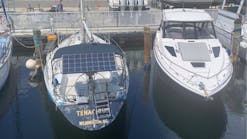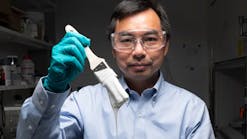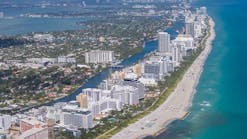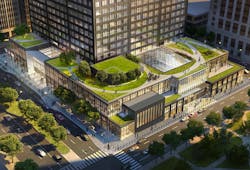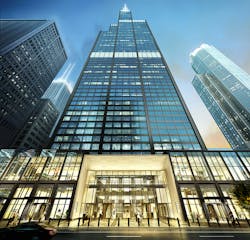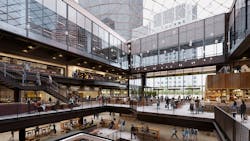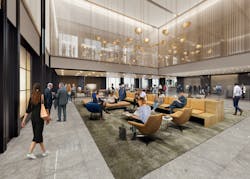From its opening in 1973, until 1998, Willis Tower — then Sears Tower — was the tallest building in the world, and I found the view from the Skydeck to be amazing. That view is particularly exhilarating on a windy day, which is almost every day in the Windy City, since the average sway of the building is approximately six inches. Willis Tower no longer has the distinction of being the world’s tallest building, but it is the largest building in the U.S. to achieve LEED Platinum certification and the largest office building to earn the Energy Star certification.
The property’s owner/manager, Blackstone’s EQ Office, characterizes Willis Tower as a neighborhood, not just an office building. That description seems fair, since the 110-story structure houses more than 100 diverse businesses employing approximately 15,000 workers. Add to that the constant flow of visitors to those businesses, the Skydeck, and the 300,000-sq-ft retail, dining and entertainment experience — appropriately named Catalog in tribute to its Sears Roebuck roots — and nearly-completed 30,000-sq-ft outdoor deck and garden, and you have a neighborhood. If the building’s 4.56 million square feet were spread out at ground level, it would form a community of 16 city blocks in downtown Chicago. Annually, 12 million people pass the building, with more than 1.7 million actually going inside.
The history of the Tower is nearly as interesting as the building itself. Designed in 1969 and begun in 1970, the building was intended to serve as the corporate headquarters for Sears, at that time the largest retailer in the U.S. Three years, 2,000 workers, and $150 million ($860 million in today’s dollars) later, the Tower welcomed its first occupants. Sears began moving out of the Tower in 1992, and had completely vacated the building by 1995. In 2009, the building was renamed Willis Tower after Willis Group Holdings, a major tenant. In early 2017, Blackstone/EQ Office launched the largest renovation project since the Tower was built and has invested more than $500 million in the building’s transformation.
In addition to extensive amenity spaces and interior improvements, the Tower has, since 2000, reduced annual electricity consumption by 34 percent, and has saved more than 10 million gallons of water per year. In addition to the installation of new lighting and lighting controls, replacement of lower efficiency electric motors, and installation of low-flow plumbing fixtures and appliances, the Tower has instituted such other sustainable accomplishments as annually recycling more than 2,103 tons of paper, aluminum, glass, plastic, and construction waste, and more than 16 tons of electronics; providing indoor bicycle parking, showers, changing rooms, complimentary loaner bikes, helmets and locks; providing incentives for hybrid/electric vehicles; installed more efficient windows; and implemented green and team cleaning programs. Other green initiatives under consideration or being planned include solar panels and new cool roof space.
The Tower, regardless of its name and occupants, has been a Chicago — and American — icon since its opening 47 years ago, and it now has the additional distinction of being an innovator in sustainability.
A regular contributor to HPAC Engineering and a member of its editorial advisory board, Larry Clark is a principal at Sustainable Performance Solutions LLC, a south Florida-based engineering firm focusing on energy and sustainability (All images from EQ Office.)

